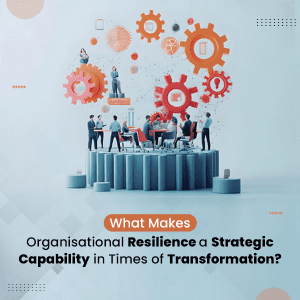
Effective change management during layoffs and reductions in force (RIF) is crucial, regardless of the underlying reasons for these changes. The ADKAR Model provides valuable guidance in this context.
Whether your company is restructuring post-merger, downsizing to match market demands, or eliminating positions for other reasons, the primary emphasis of change management should be on the employees who remain. This approach might initially seem counterintuitive.
Why Layoffs Make Change Management Challenging
Layoffs are challenging and have widespread impacts within an organisation. While some companies offer severance packages, job search assistance, and other resources to support departing employees, others may lack the ability to provide such support, complicating the change management process.
Prosci research provides valuable insights and strategies for managing layoffs and reductions in force, but the specific process an organisation follows must align with relevant employment laws.
To grasp the complexities of this type of organisational change, it is important to consider the various stakeholder groups involved.
Stakeholders impacted by Change Management in Layoffs
Two main stakeholder groups are affected by layoffs, downsizing, restructuring, or reductions in force (RIF): those who are leaving and those who remain.
Stakeholder Group 1 – The People Leaving
Managing change for departing employees is particularly challenging because their journey is largely outside of the organisation’s control. According to the ADKAR Model, fostering a Desire for change in this group is nearly impossible. Even with severance packages, job retraining, or other forms of assistance, departing employees often find little personal benefit (“What’s in it for me?”).
Human resources (HR) professionals must navigate layoffs and terminations in strict adherence to legal requirements, which can appear abrupt. Typically, employees are summoned to meetings without prior notice, informed of their termination, and escorted from the premises. HR professionals may not be able to address all employee questions and must focus on being compassionate, communicating clearly, and operating within the organisation’s constraints.
Change management for this group is limited and involves collaborating with HR to define success, develop a communication plan, anticipate resistance, and prepare appropriate responses to questions from departing employees.
Stakeholder Group 2 – The People Who Remain
The focus of change management for layoffs should primarily be on supporting those who remain with the organisation. This group includes smaller subgroups such as front-line employees, managers, contractors, and customers affected by the change.
Unlike departing employees, the change journey of those who remain is more manageable. Effective change management for this group involves planning for their adjustment and resettlement after the layoffs are complete.
Supporting all relevant stakeholders correctly is crucial to prevent resistance behaviors, employee and customer attrition, and damage to the organisation’s reputation and culture.
Getting Change Management for Layoffs Right
From a process standpoint, managing change during a layoff or downsizing is similar to handling other types of organisational changes. Employing a structured approach, such as the Prosci Methodology and its 3-Phase Process, is crucial for covering all the essential activities to achieve high success rates. This includes selecting an appropriate sponsor, determining the change management plans to implement, timing and communication strategies, and anticipating and addressing resistance.
However, there are significant differences in managing change during layoffs and downsizing.
Increased Focus on External Stakeholders
Unlike internal changes, layoffs and downsizing significantly impact customers and other external stakeholders. If the affected employees held customer-facing roles, the communication plans must address this. How will you explain the absence of the person or team that these customers or vendors have always interacted with?
Impacts on the Organisation’s Reputation
In today’s era of viral communication, companies must be extremely careful. During layoffs, the organisation is under intense scrutiny. The way you treat your employees during this period will be remembered and can have long-term effects on the company’s reputation. People form lasting opinions based on how a company handles such situations.
Impacts on Organisational Culture
Change management for layoffs involves altering the organisational culture, but unlike most planned projects or initiatives, it usually focuses on addressing and mitigating negative effects after the fact. Think of a layoff as a tear in the fabric of the organisational culture; effective change management works to mend it. Without this, you might later find yourself wondering, “How did we end up here?”
Consequences of Ineffective Change Management for Layoffs
There are methods to navigate layoffs and RIFs that allow departing employees to maintain their dignity, while also ensuring you feel you have treated them with respect. On the other hand, poor change management during layoffs can lead to incomplete or unsuccessful adoption of the change, falling short of the organisation’s expectations. Prosci describes this as the “Swiss cheese” state of a change, where gaps and holes undermine the process.
States of Change – Source: Prosci
Understanding the Implications of Change Management in Layoffs
Change management always has a purpose. The intended outcomes of a layoff might include more efficient reporting structures, enhanced customer service, or an improved financial position.
As with any change, success depends on the organisation’s members adopting and accepting it. When this doesn’t happen, the consequences accumulate over time:
Initially, you might experience short-term setbacks like a lower return on investment (ROI) from the overall initiative. Next, a history of failed changes can start to develop over the next year or two. Eventually, around three to five years later, people might reflect and say, “This isn’t what our culture used to be like.” “This isn’t what we expected.” “We used to be a great company, and now I don’t recognize who we are.” Finally, employees may begin to think, “If the company treats people this way, I should consider leaving too.”
Research on Ineffective Change Management for Layoffs and RIFs
Prosci research highlights the significant consequences of poorly managing change during layoffs. Key issues to watch for include:
- Fear – Retained employees may fear losing their jobs, making them less likely to take risks or embrace changes, as they do not want to appear supportive of the layoffs.
- Productivity Loss – A sense of futility can spread among employees, leading them to believe they might be next to go. High performers often leave for competitors out of fear, taking valuable knowledge and expertise with them.
- Absenteeism – Employees may skip meetings, activities, or events related to the change and even their regular work duties. Some may begin using all their paid time off, leading to a spike in sick days during the transition.
- Resistance to Change – Employees might actively work against the change, retaliating by sabotaging efforts or spreading misinformation, causing others to feel guilty for supporting the initiative.
Navigate the Complexities of Change Management for Layoffs and RIFs with Marg Business Transformation
The Prosci ADKAR Model offers a structured approach for navigating challenging layoffs, downsizing, reorganisations, and RIFs. When applied with a focus on the remaining employees, it helps maintain organisational integrity, morale, and overall success during transitions. By following methodologies such as the Prosci Methodology and 3-Phase Process, organisations can more effectively support all stakeholders, ensure smoother transitions, and promote a culture of transparency, dignity, and respect.
For those seeking expert guidance and certification in change management, Marg Business Transformation, with their legacy of more than 16 years, stands as the exclusive Prosci affiliate in India, offering authoritative guidance and certification in change management. Their services encompass comprehensive change management certification and training, catering to those in search of expert guidance and accreditation in this field.






